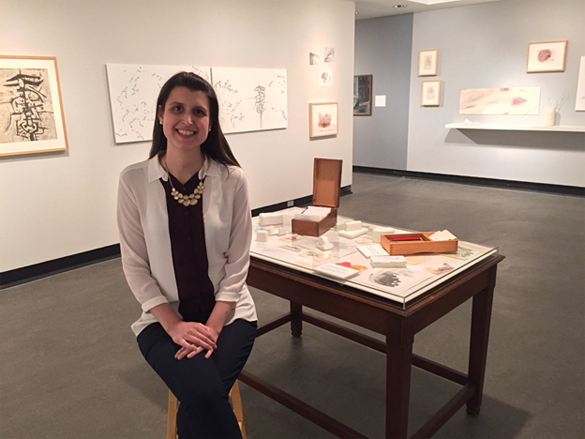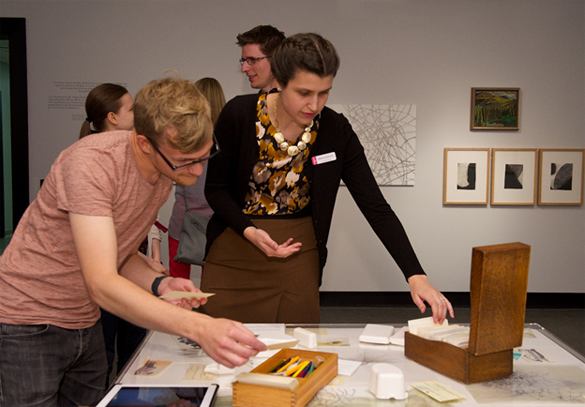By Emily Putnam
As we move towards the end of the winter term, graduating students reflect upon the past two years, feeling nostalgic about the people we’ve met and the experiences we’ve had. As graduate students, some of us are consumed with the age-old question: Where do we go from here?
While I remain steadfast in my own post-MA journey, this question is not lost upon me. I recently interviewed Carleton Art History MA graduate (2013) and current Assistant Curator at the Ottawa Art Gallery, Rebecca Basciano, on her writing routine, most beloved experience from grad school, and her post-grad life.

Gail Bourgeois: Correspondence, from roots to rhizomes to mycelial networks, Installation View, Ottawa Art Gallery, 2016.
EP: An almost impossible question for an art historian, but if you could pick one museum or gallery anywhere in the world as your favourite, what would it be?
RB: There are so many galleries around the world I have yet to visit, and I am inspired for equal yet different reasons by the ones I have seen.
Interestingly, the first moment I truly felt the transformative power of art, I wasn’t in a gallery. It happened in a small undecorated church with high Gothic vaulting, tucked away on a side street of Paris. There was something transcendent about that church for me, and whenever a gallery, an exhibition, or a work of art can help re-create part of that feeling I consider it a success.
EP: Do you have a favourite place to write or routine that helps your productivity?
RB: I ensure I am in a tranquil environment free of distractions. I usually write at home where I can put on classical music, a pot of tea, and some incense. I also find that I am most productive in the morning and try to make the best use of those hours.
EP: What was your biggest fear when you started graduate school? And when you graduated?
RB: I was actually very excited to begin my MA at Carleton University. I went directly from undergraduate studies to graduate school because I was so passionate about the subject and was filled with a sense of direction and purpose.
Upon graduating with an MA, however, I didn’t have that same sense of direction. I knew that I would not give up on finding a job related to my studies and my passion, but was intimidated by the looming question “Where do I go from here?” I eventually realized that I had to get my feet wet, anywhere and any way that I could.
EP: What was the biggest influence on your decision to become an art historian?
RB: In retrospect, it was something that was always a part of me. Even before I could read I routinely flipped through art books my parents had picked up during their travels, and in high school my photography teacher once told me that my photographs were good – but that I wrote about them better.
It wasn’t until I went to Western University to pursue an undergraduate degree that I was introduced to the idea of Art History as a discipline. I enrolled in a survey of Art History course and was amazed by this whole new world that had opened up to me. I took to it immediately and haven’t looked back since.
EP: What was your best experience in graduate school?
RB: My practicum placement at the Carleton University Art Gallery (CUAG) was one of my best graduate school experiences. I had the opportunity to do some intensive research on artists I had never considered before, which in turn, stimulated the development of my personal studies. I was deeply inspired by the professionalism and creativity of Director Sandra Dyck along with the entire staff and found it to be a valuable hands-on experience that has prepared me for the job I hold today.
EP: What are you doing now in your post-grad life?
RB: I have been working at the Ottawa Art Gallery (OAG) since 2013, where my current role as Assistant Curator includes researching and developing exhibitions, as well as managing OAG’s acquisitions and touring exhibition programs. I recently curated Gail Bourgeois: Correspondence, from roots to rhizomes to mycelial networks (2016), and was both writer and publication coordinator for the accompanying catalogue. I have also organized several exhibitions related to the Gallery’s Firestone Collection of Canadian Art, including Ottawa Selects (2015) and Coast to Coast (2016). I handle artists’ submissions, artwork donor relations, applications for Certified Canadian Cultural Property, and have managed the national tours of OAG’s exhibitions Alma: The Life and Art of Alma Duncan (1917-2004) (2014-16) and Decolonize Me (2011-15). My current projects include coordinating the ten-month schedule of upcoming exhibitions for OAG Out There in the lead-up to the opening of the new OAG.

Gail Bourgeois: Correspondence, from roots to rhizomes to mycelial networks, Installation View, Ottawa Art Gallery, 2016. Photo: David Barbour.
EP: You recently curated your first exhibition for the Ottawa Art Gallery. Congratulations, it was a beautiful exhibition. Can you tell me about the exhibition and the process that went into putting it together?
RB: Gail Bourgeois: Correspondence, from roots to rhizomes to mycelial networks (June 4 – September 18, 2016) was the latest iteration of OAG’s Firestone Intervention Series – exhibitions showcasing compelling new work by local artists inspired by their engagement with the Firestone Collection of Canadian Art.
Over the course of a year artist Gail Bourgeois and I engaged in countless discussions and collaborations, either in her studio, or in the Gallery vaults sifting through some of the most astounding, yet overlooked, sketches in our collection. It was such a pleasure to work with Gail – her enthusiasm, dedication, and creative process was inspiring. Through her, I was initiated into the philosophical thinking of Gilles Deleuze and Félix Guattari, as she drew inspiration from rhizomes and mycelial networks found in nature, intermingled with themes such as multiplicity and cartography.
Gail’s works were displayed beside the work of artists Arthur Lismer, A.Y. Jackson, Edmund Alleyn and Anne Savage, creating an enriched understanding of the motifs and subject matter explored in our collection. I hung the works in a relatively non-linear way, and created an interesting dialogue between the works on the wall and Gail’s objects cast from consumer packaging, floating on shelves underneath. I also wrote the text and coordinated a catalogue to accompany the exhibition. Rather than a single essay, I mirrored the exhibition and the philosophical theories by instead dividing my writing into subtexts that offered several entry points into the work.
EP: What is the most valuable piece of advice you can give to soon-to-be graduates entering the field?
RB: It is important to gain hands-on experience, either through permanent positions, term contracts, or volunteering. I would also suggest attending as many talks, events and exhibition openings as you can to strengthen your investment in your local arts community.